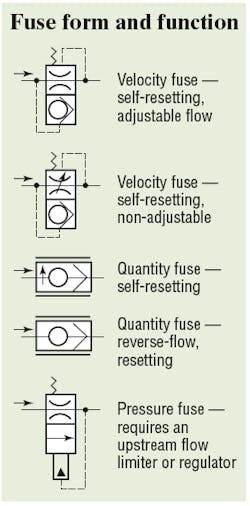This file type includes high resolution graphics and schematics when applicable.
Why aren't hydraulic fuses as commonplace as electrical counterparts? They are not required by law, so cost seems to be the main objection. Even though the cost of a fuse may be less than $100, not using one could cost hundreds of thousands in litigation, especially if a fuse in a circuit would have prevented a serious accident.
In addition to cost, nuisance trips (closing of the fuse when it is not supposed to) are another reason why hydraulic fuses may not be specified. However, nuisance can be overcome by specifying the right fuse for an application.
Operation and options
Hydraulic fuse is a general term given to three different types of devices — velocity fuses, quantity fuses, and pressure fuses.
Velocity fuses work by sensing flow across a control orifice when the pressure differential exceeds a predetermined amount (usually 50 psid). A spring-biased poppet closes, shutting flow to the damaged hydraulic circuit.
A velocity fuse requires a flow potential large enough to meet the differential pressure setting. The flow normally required to trip the fuse is 30% above the rated flow. This usually accommodates flow surges without tripping the fuse. Flow surges can be caused by sudden starts and stops, valve actuations, motor reversals, etc. The fuse allows reverse free flow. Depending on the system requirements, velocity fuses can reset automatically when the pressure is removed or with reverse flow.
An adjustable velocity fuse can optimize the fuse trip setting and can be externally adjusted to provide a flow trip setting without having to disconnect the hydraulic lines. Once the fusing flow is set, the housing can be locked for repetitive operation.
Quantity fuses are used in hydraulic circuits that have a limited fixed volume, a clutch or locking circuit, for example. A quantity fuse senses flow across two orifices sized to provide a specific volume. Quantity fuse volume generally is sized to be less than 1⁄2 gal. Refer to schematic 3 and 4.
Pressure-sensing fuses operate by sensing low pressure (low load) for valve actuation. Flow potential must be limited such that the outlet pressure does not exceed the fuse actuation pressure.
Special functions
To overcome nuisance trips, a time delay feature in a velocity fuse allows an overshoot above rated flow for up to 0.2 sec before closing. This prevents nuisance trips caused by sudden flow surges.
Elevator and lift applications may mandate a maximum deceleration. Other requirements include safety pressure rating (7to 8 times normal operating pressure), maximum speed, and performance requirements. To meet these requirements, a variable orifice incorporated into the velocity fuse limits the shock load to less than
0.3 Gs and closing time to less than 0.2 sec.
In summary, when selecting a hydraulic fuse, you must have a clear understanding of the operation of the hydraulic system and apply the proper fuse for maximum protection.
Submitted by Gordon Yowell, Predator Systems Inc., Boca Raton, Fla. For more information, call (561) 394-9991, ext. 209 or visit www.predatorsystemsinc.com.
This file type includes high resolution graphics and schematics when applicable.



